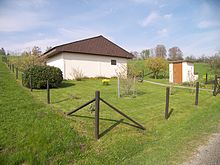Eschenberg observatory
The Eschenberg observatory is an observatory in Winterthur in the canton of Zurich in Switzerland . It was built in 1979 by the Astronomical Society Winterthur in a light-protected location in a clearing in the Eschenberg forest . In the meantime, the small observatory has developed into an institution that is known far beyond the country's borders and combines the public observatory , planetoid research and digital astrophotography. In November 2018 the book "Winterthurer Sternstunden - 40 Years of Eschenberg Observatory 1979 - 2019" was published, which on almost 100 pages and with many photos and graphics gives an insight into the diverse work of this successful observatory. Markus Griesser , the co-initiator and long-time director of the observatory, is the author .
tasks
The Winterthur observatory offers astronomical tours for a wide audience, schools and groups and has also been used for scientific tasks since 1998. To date, Markus Griesser has transmitted well over 22,000 high-precision position measurements from this station, more than two thirds of them from near-Earth asteroids , to the Minor Planet Center in the USA. Such measurements are required for precise orbit determinations . In so-called Potentially Hazardous Asteroids ( Potentially hazardous asteroids ) help with it, a possible Impaktrisiko estimate for the Earth early. A total of ten main belt asteroids were also discovered, named after the city of Winterthur , Griesser's place of residence Wiesendangen and the Winterthur musician and orchestra director Hanna Wieser .
Furnishing
The Eschenberg observatory has had a bright 60cm f / 3.8 astrograph with a large electronic camera for its scientific tasks since autumn 2014 . The ultra-modern instrument is controlled in all of its functions via a wireless network (WLAN). In honor of the Winterthur entrepreneurs Robert and Ruth Heuberger, who made a significant contribution to the financing with their foundation, the new instrument is officially named "Heuberger Astrograph". A powerful telescope , a 20cm refractor of the most modern design, is available for public use, which also allows high magnifications when the air conditions are favorable. And for sophisticated astrophotography, which has recently become a third focus of the Eschenberg observatory's commitment, a particularly powerful Ritchey-Chrétien reflector telescope with a 40cm mirror f / 8.0 and the most modern CCD cameras has been used since July 2017 .
The conception of the observatory with a sliding roof instead of a dome allows observations of large areas of the sky with the naked eye or with binoculars. Explanations of currently visible constellations , interesting individual stars and planets are possible. Thanks to this open roof structure, the public can follow the migration of satellites and the fall of falling stars .
Data
The observatory has the following geographical coordinates (according to the reference system WGS 84):
- 47 ° 28'28.9 "N.
- 8 ° 44'34.1 "E.
- Height: 542 m above sea level M.
Varia
- The 5.6 km small asteroid (96206) Eschenberg is named after the observatory . The asteroid was given this name by the German astronomer Freimut Börngen from Jena , who named it "Eschenberg" in honor of the Winterthur astronomers.
Web links
- Extensive homepage with detailed information and many links.
- Report from Radio Top with audio contribution
Individual evidence
- ↑ An asteroid named Eschenberg. In: The Landbote . June 12, 2017. Retrieved June 13, 2017 .
Coordinates: 47 ° 28 '28.9 " N , 8 ° 44' 34.1" E ; CH1903: six hundred and ninety-eight thousand three hundred and ten / 259030
